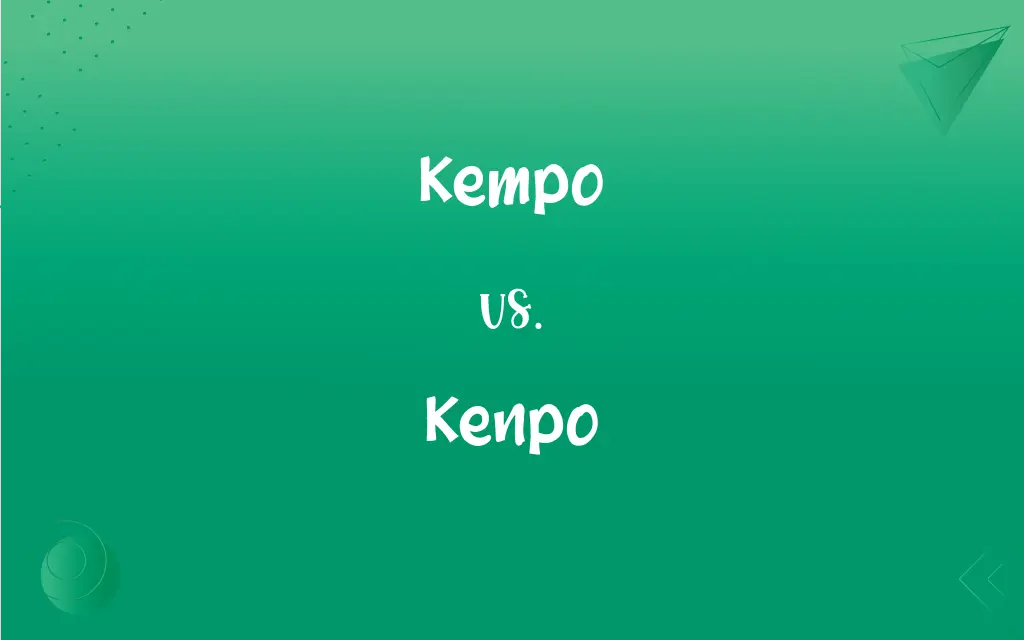Kempo vs. Kenpo: What's the Difference?
By Aimie Carlson & Janet White || Published on March 10, 2024
Kempo is a traditional Japanese martial art focusing on hand strikes and kicks, while Kenpo, often American Kenpo, blends these techniques with Western boxing and grappling moves.

Key Differences
Kempo, originating from Japan, emphasizes fluid, circular movements, prioritizing precision and efficiency in strikes. It is deeply rooted in Zen Buddhism, influencing its philosophy and techniques. Kenpo, especially American Kenpo, adapts these principles but incorporates more aggressive tactics, rapid punches, and kicks, reflecting a more modern, eclectic approach to self-defense. The emphasis in Kenpo is often on practicality and adaptability, making it suitable for varied real-world scenarios.
Kenpo's evolution in the West, particularly in the United States under Ed Parker, led to a system that is highly structured, with a clear belt ranking system and predefined sets of movements known as katas. Kempo, in its traditional form, maintains a less rigid structure, focusing more on the flow of movement and the martial artist's internal development.
Training in Kempo often involves a significant amount of kata practice, aiming to perfect form and understanding of movement. In contrast, Kenpo training is more dynamic, with a strong focus on sparring and application of techniques in realistic settings.
The philosophical underpinnings of Kempo emphasize harmony and the spiritual journey of the practitioner, seeking to achieve balance and a deeper understanding of oneself. Kenpo, while not devoid of philosophical aspects, often places a greater emphasis on the practical aspects of self-defense and the physical benefits of martial arts training.
Despite their differences, both Kempo and Kenpo share a common goal of personal development, self-defense, and the promotion of physical and mental health. The choice between them often depends on the individual's personal goals, interests, and the specific style of the martial art available in their area.
ADVERTISEMENT
Comparison Chart
Origin
Japan
Adapted in the West, particularly the USA
Techniques
Emphasizes fluid, circular movements
Combines traditional movements with Western boxing and grappling
Philosophy
Rooted in Zen Buddhism
Focuses on practicality and adaptability
Structure
Less rigid, more focus on flow and internal development
Highly structured, with a clear belt ranking system
Training Focus
Kata practice and perfection of form
Dynamic sparring and realistic application of techniques
ADVERTISEMENT
Kempo and Kenpo Definitions
Kempo
Deeply philosophical, with an emphasis on internal development.
Kempo classes sometimes include meditation to enhance focus.
Kenpo
An American adaptation of Kempo, blending Eastern techniques with Western boxing.
Kenpo practitioners utilize rapid punches and kicks in their repertoire.
Kempo
A traditional Japanese martial art focusing on precise strikes and kicks.
In Kempo, practitioners learn to deliver efficient hand strikes with minimal effort.
Kenpo
Known for its aggressive tactics and practical application.
Kenpo training includes scenarios that simulate real-life confrontations.
Kempo
Prioritizes precision and efficiency in self-defense.
Kempo teaches how to neutralize threats with swift and targeted moves.
Kenpo
Features a highly structured belt ranking system.
Students in Kenpo must master specific katas to advance to the next level.
Kempo
Characterized by its fluid and circular movements.
Kempo techniques often involve using the opponent's force against them.
Kenpo
Incorporates a modern, eclectic approach to martial arts.
Kenpo classes often integrate exercises that improve flexibility, speed, and power.
Kempo
Less structured in terms of progression compared to Western martial arts.
In Kempo, progression is more about personal journey than belt color.
Kenpo
Focuses on dynamic sparring and realistic self-defense.
Kenpo emphasizes the importance of adapting techniques to fit the situation.
Kempo
Variant of kenpo.
Kenpo
Any of numerous forms of karate characterized by very sharp blows and kicks.
Kenpo
Any of various Japanese martial arts.
FAQs
What is the main difference between Kempo and Kenpo?
The main difference lies in their origins and techniques; Kempo is traditional Japanese martial art focusing on fluid movements, while Kenpo is an American adaptation that includes more aggressive tactics.
Is Kempo better than Kenpo for self-defense?
Both are effective for self-defense, but Kenpo is often seen as more practical for various real-world scenarios due to its eclectic approach.
Can Kenpo be considered a type of Kempo?
Yes, Kenpo can be considered a derivative of Kempo, adapted with additional influences from Western martial arts.
Do Kempo and Kenpo share the same belt ranking system?
No, Kenpo, especially American Kenpo, has a more structured belt ranking system compared to the traditional Kempo system.
Which is more suitable for children, Kempo or Kenpo?
Both can be suitable for children, but Kenpo's structured system and dynamic nature might be more engaging for young learners.
How long does it take to achieve a black belt in Kempo vs. Kenpo?
The time to achieve a black belt varies greatly depending on the dojo, the frequency of training, and the individual's dedication, but Kenpo often has a more defined timeline due to its structured system.
Are the philosophical aspects of Kempo present in Kenpo?
While Kenpo incorporates some philosophical aspects, its emphasis is more on practicality and physical benefits, unlike Kempo, which is deeply rooted in Zen Buddhism.
Is it necessary to have a martial arts background to start learning Kempo or Kenpo?
No, both Kempo and Kenpo welcome beginners without any martial arts background, offering foundational classes that build up skills progressively.
Can Kempo or Kenpo be practiced alone, or does it require a partner?
While some aspects can be practiced alone, such as forms and shadow boxing, partner training is crucial for applying techniques and sparring.
Can Kempo and Kenpo be used in mixed martial arts (MMA)?
Yes, both Kempo and Kenpo techniques can be adapted for use in MMA, especially their striking techniques and the adaptability taught in Kenpo.
What are the health benefits of practicing Kempo or Kenpo?
Both offer cardiovascular fitness, improved flexibility, strength, mental discipline, and stress reduction among their many health benefits.
How do practitioners of Kempo and Kenpo view each other?
While there is mutual respect among practitioners, there may also be debates on the effectiveness of traditional vs. modern techniques.
Is there a competitive aspect to Kempo or Kenpo?
Competitions exist in both disciplines, though they may vary in focus, with Kenpo often having more opportunities for sparring competitions.
Are there any famous practitioners of Kempo or Kenpo?
Yes, several martial artists and celebrities have trained in Kenpo, including Ed Parker, a key figure in American Kenpo, and many others who have helped popularize these arts.
Can Kempo or Kenpo training be customized for personal goals?
Yes, instructors can tailor training in both martial arts to meet personal goals, whether for fitness, self-defense, or spiritual development.
Do Kempo and Kenpo require physical fitness to start?
While physical fitness can be beneficial, neither Kempo nor Kenpo requires it to start; both disciplines will help improve fitness levels through training.
How do Kempo and Kenpo handle weapon training?
Weapon training is more prominent in certain styles of Kempo, focusing on traditional Japanese weapons, while Kenpo may include weapon defense techniques within its curriculum.
What role does meditation play in Kempo training?
Meditation is integral to Kempo, aiding in focusing the mind and understanding the deeper philosophical aspects of the martial art.
Are there different styles within Kempo and Kenpo?
Yes, there are various styles within both Kempo and Kenpo, each with its own focus, techniques, and interpretations of the martial art.
What is the emphasis of training in Kempo?
Kempo emphasizes fluidity, precision, and the philosophical integration of mind, body, and spirit in martial arts practice.
How does Kenpo address multiple attackers in self-defense scenarios?
Kenpo training often includes strategies and techniques specifically designed to deal with multiple attackers, emphasizing awareness and efficiency.
What is the best way to find a reputable Kempo or Kenpo school?
Researching schools, visiting classes, and talking to instructors and students can help find a school that matches one's personal goals and philosophy.
Do Kempo and Kenpo have spiritual components?
Kempo has a stronger spiritual component, rooted in Zen Buddhism, while Kenpo's focus is more on the physical and practical aspects.
How does the teaching methodology differ between Kempo and Kenpo?
Kempo may focus more on individual exploration and understanding of principles, while Kenpo offers a more systematic approach with defined techniques and goals.
About Author
Written by
Aimie CarlsonAimie Carlson, holding a master's degree in English literature, is a fervent English language enthusiast. She lends her writing talents to Difference Wiki, a prominent website that specializes in comparisons, offering readers insightful analyses that both captivate and inform.
Co-written by
Janet WhiteJanet White has been an esteemed writer and blogger for Difference Wiki. Holding a Master's degree in Science and Medical Journalism from the prestigious Boston University, she has consistently demonstrated her expertise and passion for her field. When she's not immersed in her work, Janet relishes her time exercising, delving into a good book, and cherishing moments with friends and family.































































